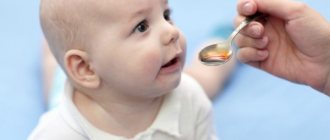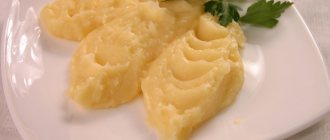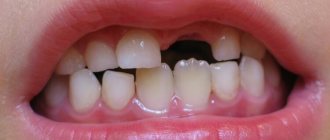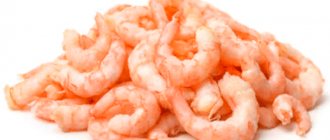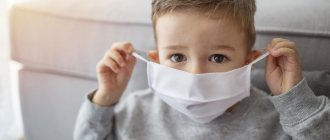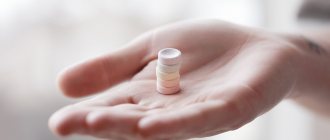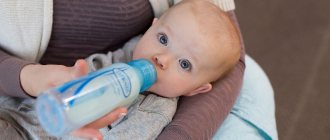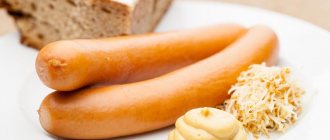When and at what age should you start brushing your child’s teeth: advice from dentists
Baby teeth are of great importance for a baby, because their task is to cut a path for the main teeth. In addition, they must chew food well, which ensures the growth and development of the child. They also help the child develop good diction and pronunciation. You can take care of the health of children's teeth with the help of properly selected toothpaste and brush. You should monitor your child’s oral hygiene from infancy (the first months of birth). Of course, each age requires its own special care.
How to care for your mouth and teeth:
- Infants should be placed on your lap, gently supporting their head. The finger should be wrapped in a sterile piece of gauze or put on a special finger cap. Insert a finger dipped in water or special foam into the baby’s open mouth and gently rub it along all the walls of the mouth, removing any remaining food. It is advisable to do this procedure after feeding twice a day.
- With the appearance of the first teeth (up to 1 year), you should change the way you care for your mouth. For those children who already have several teeth and are going through the teething period, there are special silicone brushes that help not only clean their teeth, but also “scratch” aching gums. These brushes can be washed with soapy water and sterilized in boiling water; they tolerate high temperatures well.
- Older children (after 1 year) , when the baby’s jaw already has enough teeth, you can start brushing them with a toothbrush with a special children’s paste. You should choose a paste based on the exact age (written on the package). Show your child how to brush his teeth correctly to encourage him to do it on his own, but use your own hand to thoroughly clean the mouth at least 2 times a day.
Show your child a good example
Mistakes in teaching a child to brush their teeth
Most often, parents explain the importance for their child to brush their teeth because of dangerous worms that damage teeth. The child picks up information selectively, and such things frighten him greatly. If a child develops the habit of brushing his teeth regularly, he will not need to know about the possible pain and fears of dentists.
Speaking of the latter, parents love to intimidate with scary dentists. As a result, children are obviously afraid of them, and at the same time of other doctors. You never know why a child will have to be taken to the dentist; it is not always due to insufficient oral care; there is no need to instill fear in him of such a specialist, especially since now even treatment has become painless and comfortable. By the way, you should also visit the doctor regularly, ask the dentist to enthusiastically praise the child for healthy teeth, you can even prepare a symbolic gift in advance for the doctor to give.
And remember, although experts say that the main thing is to remove sticky plaque from the enamel in a timely manner, excessive consumption of sweets can harm not only the teeth, but also the digestive system, and can provoke allergies or simply diathesis. Therefore, it is better to form healthy eating and health habits in your child from a young age.
If you liked the article, please share a link to it
How to brush the teeth of a child under one year old, one year old and older: tips
IMPORTANT: From the time a child has 20 baby teeth, he should regularly visit the dentist so that he can prevent the occurrence of caries.
How to brush a 1 year old child's teeth:
- Choose a special baby toothpaste for your baby
- If the baby swallows the paste, it’s okay, since it is designed for such a mistake.
- Brush your teeth very carefully so as not to scratch or injure your gums.
- Choose only a brush with soft and not hard bristles for cleaning your baby.
- The head of a children's toothbrush should not cover more than two teeth - then it will thoroughly clean them.
- Make cleaning fun, playfully, humming a song or reading rhymes, so that the child perceives the process as a game (for fun cleaning, you can choose a colored brush with drawings).
How should a child keep his mouth clean?
What to do in such cases? How to make brushing your teeth fun?
Method 1
Well, of course, the child needs his own personal brush. And not simple, like adults (without pictures), but bright, original and unusual. It is best if the child chooses a brush for himself from those offered to him by his parents (who will inquire in advance about the manufacturer and quality). The brush should be chosen according to age, regular or electric (from 3 years old). Preference should be given to brushes with soft bristles so as not to scratch the delicate enamel on children's teeth. By the way, it is quite possible to purchase two brushes, one for morning cleaning, the second for evening.
Method 2
What would brushing your teeth be without toothpaste? In the modern world, there is a great variety of children's pastes with different tastes and smells that children will like. BUT you should remember that not every “tasty” pasta can be healthy for your baby. Before buying, you need to inquire about the composition. For babies, the best toothpaste is one that does not contain fluoride.
Method 3
Toys are used. You can start a fun game of dentist for dolls and show them how to brush their teeth correctly. Or maybe that teddy bear wants to brush the bunny’s teeth? First, with the help of mom or dad, and then you can do it yourself. Little by little, slowly, the baby will get used to brushing his teeth on his own, not only in front of spectator dolls, but also in the bathroom, in front of the mirror.
Method 4
Pleasant music can accompany the process of brushing your teeth. Let it be the baby's favorite tune or song, and while it plays, the baby brushes his teeth.
Method 5
A tricky agreement between parent and child. For example, we will mark together on a special calendar how you brushed your teeth. And if everything goes without any whims, we decorate the sun (draw a cheerful face, glue a sticker). A week without whims - a little chocolate. A month without whims is a small toy. If for some reason the child is naughty, we deduct a penalty point. Children love rewards for their efforts; this method is quite effective.
Method 6
We watch interesting cartoons on dental topics or read a funny book. Does a child want to be like capricious Masha, who didn’t brush her teeth and got a toothache? Or maybe Bunny the Doctor will teach careless Masha how to properly and carefully take care of her teeth? Illustrative examples provide an undeniable impetus for the promotion of oral care education.
Method 7
Of course we draw! Creativity will help the child express his feelings. You can draw and decorate teeth in different colors, come up with a funny little man with funny teeth. “Cure” a diseased tooth by painting it completely white.
Method 8
Fairy tales. Thematic, psychological, which will show different life situations. This will help the child look at himself from the outside. For example:
Scheme of proper brushing of front and back teeth for children
Proper mouth brushing techniques will help you monitor the health of your children's teeth:
- First of all, use a brush to “sweep away” all the “dirt” from the chewing teeth at the bottom, and then at the top.
- There should be at least 10 brush strokes per 1-2 teeth.
- After you have cleaned your chewing teeth, you should start cleaning your front teeth.
- The movements of the brush on the front teeth should be directed up and down, and then become circular.
- Then start cleaning the inside of the tooth (the part that comes into contact with the tongue).
- Movements on the inside of the tooth should first be “sweeping away dirt” and then to the sides.
- Sweeping movements of the brush should be carried out at the top and bottom.
- Rinse your mouth thoroughly, spitting out any remaining toothpaste.
How to properly brush children's teeth: diagram
How to teach a child to brush his teeth at 2 years old: recommendations
Parents can teach their child to brush their teeth correctly and with pleasure by setting a positive example. They should regularly involve their baby in morning hygiene procedures, buy him a toothbrush and a special toothpaste (be sure to taste it, make sure it is sweet and not too minty).
In order not to frighten your baby with toothpaste (its color, taste, consistency), first brush the teeth with a brush dipped in warm water. Over time, add a smear of paste on the brush, then a pea, and so on until the required amount. Sooner or later, the child will become interested in this process and will snatch the brush from you shouting “I myself.” Carefully adjust his movements by guiding your hand correctly and touching all the teeth in the mouth.
Main rules
First rule: teach by example
The child should be taken with him to the bathroom so that he can see how mom, dad, or older brother or sister brush their teeth. Let him observe and show interest himself. He will definitely want to copy what adults do - this is an integral quality of all kids. This advice may seem banal, but many parents forget about it: they show, tell, explain, but still fail to teach. Why? The answer is simple: parents do not show this by example.
Second rule: don't force
If the baby doesn’t want to, don’t swear if he doesn’t succeed. After all, if parents show negative emotions, then the child will associate dental care with them, and the attitude towards the procedure will be appropriate. Do you need it? I think no.
Choose a toothbrush and toothpaste based on the child’s age. Fortunately, this is not a problem now. Typically this information is indicated on the packaging. The brush should not be too hard. The optimal brush head size is two teeth.
At first, while the baby is just learning a new activity, you can brush your teeth with a brush dipped in water without toothpaste. When he learns, the amount of paste that needs to be squeezed out of the tube for one brushing is approximately equal to one child’s tooth.
Third rule: teach through play
Fun games will help arouse interest and give your child pleasure during dental care.
- Let's play spitting game. Before using toothpaste, teach your baby to spit. For example, while swimming. Let him take small sips of boiled water into his mouth and spit it out into the sink, just be sure to do this with him.
- Let's rinse our teeth. Another game is rinsing. Teach your child to rinse his mouth with water. Show how to do this, let the child listen and feel what sounds the water makes when it splashes in the mouth while rinsing. Task: do not swallow.
- The sand is pouring down - the teeth are being brushed. How long does it take to brush your teeth? Optimally 1-2 minutes. Of course, for a little fidget this is a lot of time, he may get bored. And this is where the game comes to the rescue. Buy a children's hourglass. Come up with a plot, for example: will Vanya be able to brush her teeth until all the sand spills out? Let the baby turn the clock over and observe.
- Let's play and choose. Let the baby have not one, but several toothbrushes of different colors. And every day he will choose with interest which brush will clean his teeth today.
- Let's brush the bear's teeth. You can take your favorite toys: a bear, a bunny, a doll. Let them brush each other's teeth (with the help of mom's hand, of course). Now let the baby help them take care of their teeth, then they will help him. And then the baby will show the toy spectators how to brush their teeth on their own.
- Let's draw and fantasize. Tell your baby about the Tooth Fairy, who gets upset when children don’t brush their teeth, draw with your baby on a “tooth theme”, come up with, for example, a fairy tale about the Tooth Brothers and the importance of keeping them clean.
So, the main assistants for parents in teaching their child to care for their teeth are: a good mood, personal example, fun games, and, of course, the ability to fantasize, invent, and improvise. The gaming moment, as the baby grows up, will fade into the background, but the useful habit and the positive emotions associated with it will remain.
The child does not want to brush his teeth: what to do?
As practice shows, not all kids like brushing their teeth. Many children perceive this process quite critically, throwing tantrums and scandals. This is very problematic, because it is imperative to take care of your oral cavity - this is the key to health. Every parent can teach a child to brush their teeth; it is enough to turn this process into a game.
Adviсe:
- Buy the most beautiful toothbrushes (you can have several so that your child can try them out and choose the one he likes best).
- Do the same with pastes, buy several types (strawberry, berry, mint) and let your child decide what he “likes.”
- The cleaning process should become a game or entertainment, do not be shy to make faces in front of the mirror, make your baby laugh, turn on music, dance.
- Do everything to cheer up your child and then he will happily run to brush his teeth more than once a day.
- After the procedure, show your baby a mirror and let him admire his reflection. Praise the child, say that he is doing great, “like mom” or “like dad.”
Fun brushing teeth in front of a mirror with a baby
When can a child brush his or her own teeth?
By about two years of age, you can teach your child to brush their teeth on their own. Demonstratively trust your child with this procedure. It is advisable for adults to first quickly brush the brush themselves, then let the child finish cleaning.
Buy brushes according to age, they differ in softness. The brush should be interesting, and the toothpaste should be pleasant: some children do not like certain tastes or textures of toothpaste, find one that your child likes. Children often prefer gel toothpastes. You shouldn't get hung up on the brand while your goal is to form a child's teeth-brushing habit, but it's better to choose the right children's toothpaste right away.
Be sure to brush your teeth together! Your own example of caring for your teeth is the best and most effective method.
Children love to repeat everything after their idols - their parents. Place your child's brush with an adult, show him that you are equal. Praise your child more often for his clean teeth, ask him to open his mouth and show him. As you get older, you can race to brush your teeth.
